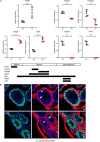The cell adhesion molecule BT-IgSF is essential for a functional blood-testis barrier and male fertility in mice
- PMID: 29123028
- PMCID: PMC5766970
- DOI: 10.1074/jbc.RA117.000113
The cell adhesion molecule BT-IgSF is essential for a functional blood-testis barrier and male fertility in mice
Abstract
The Ig-like cell adhesion molecule (IgCAM) BT-IgSF (brain- and testis-specific Ig superfamily protein) plays a major role in male fertility in mice. However, the molecular mechanism by which BT-IgSF supports fertility is unclear. Here, we found that it is localized in Sertoli cells at the blood-testis barrier (BTB) and at the apical ectoplasmic specialization. The absence of BT-IgSF in Sertoli cells in both global and conditional mouse mutants (i.e. AMHCre and Rosa26CreERT2 lines) resulted in male infertility, atrophic testes with vacuolation, azoospermia, and spermatogenesis arrest. Although transcripts of junctional proteins such as connexin43, ZO-1, occludin, and claudin11 were up-regulated in the absence of BT-IgSF, the functional integrity of the BTB was impaired, as revealed by injection of a BTB-impermeable component into the testes under in vivo conditions. Disruption of the BTB coincided with mislocalization of connexin43, which was present throughout the seminiferous epithelium and not restricted to the BTB as in wild-type tissues, suggesting impaired cell-cell communication in the BT-IgSF-KO mice. Because EM images revealed a normal BTB structure between Sertoli cells in the BT-IgSF-KO mice, we conclude that infertility in these mice is most likely caused by a functionally impaired BTB. In summary, our results indicate that BT-IgSF is expressed at the BTB and is required for male fertility by supporting the functional integrity of the BTB.
Keywords: BT-IgSF (IgSF11); IgCAM; IgCAM BT-IgSF (IgSF11); blood–testis barrier; cell adhesion; connexin43; male fertility; spermatogenesis; testis.
© 2017 by The American Society for Biochemistry and Molecular Biology, Inc.
Conflict of interest statement
The authors declare that they have no conflicts of interest with the contents of this article
Figures






References
-
- Suzu S., Hayashi Y., Harumi T., Nomaguchi K., Yamada M., Hayasawa H., and Motoyoshi K. (2002) Molecular cloning of a novel immunoglobulin superfamily gene preferentially expressed by brain and testis. Biochem. Biophys. Res. Commun. 296, 1215–1221 - PubMed
-
- Katoh M., and Katoh M. (2003) IGSF11 gene, frequently up-regulated in intestinal-type gastric cancer, encodes adhesion molecule homologous to CXADR, FLJ22415 and ESAM. Int. J. Oncol. 23, 525–531 - PubMed
-
- Matthäus C., Langhorst H., Schütz L., Jüttner R., and Rathjen F. G. (2017) Cell–cell communication mediated by the CAR subgroup of immunoglobulin cell adhesion molecules in health and disease. Mol. Cell. Neurosci. 81, 32–40 - PubMed
-
- Eom D. S., Inoue S., Patterson L. B., Gordon T. N., Slingwine R., Kondo S., Watanabe M., and Parichy D. M. (2012) Melanophore migration and survival during zebrafish adult pigment stripe development require the immunoglobulin superfamily adhesion molecule Igsf11. PLoS Genet. 8, e1002899. - PMC - PubMed
-
- Harada H., Suzu S., Hayashi Y., and Okada S. (2005) BT-IgSF, a novel immunoglobulin superfamily protein, functions as a cell adhesion molecule. J. Cell. Physiol. 204, 919–926 - PubMed
Publication types
MeSH terms
Substances
Grants and funding
LinkOut - more resources
Full Text Sources
Other Literature Sources
Molecular Biology Databases
Research Materials

